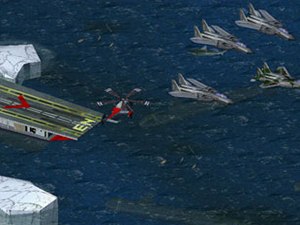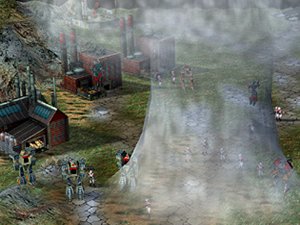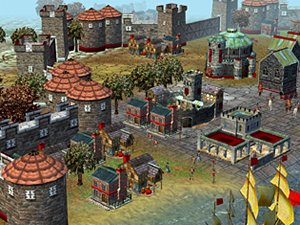Don’t You Hear It Calling?
Remember this one. Honor it. Say its name with pride. Somewhere in its lineage
to come, long after its original name (Age of Empires II.V) has
been forgotten and shoveled into mental landfills along with boy-band dance moves,
it, or something very like it, just may make the day of a kid like you (or like
the kid you once were) by allowing you to play games in History class without
actually absorbing any potentially-distracting, specific knowledge. Empire
Earth is an epic, sprawling real-time strategy game that imparts a general,
sweeping sense of History’s grandeur without resorting to that lowest, creepiest
endeavor known as “edutainment.”
Starting
out with an excellently-done tutorial (presented with instant-gratification
voice work and short range rewards that give even first time players a feel
for the game’s objectives), Empire Earth leads you through single-player
campaigns devoted to four different nationalities in four different historical
periods. The epochs include the English of the Middle Ages, the ancient Greeks,
the World War I-era Germans, and the next-century Russians.
Never too early to learn an important, brutal truth here: despite the
game’s exciting mix of units that tempt one to just rush out there and mix it
up tank (or pikeman, or musketeer) rush style, the game gets complicated very
quickly; more quickly, in fact, than it takes to reach a new epoch.
Each one of the mind-numbing array of units has complex strategic relationships
with each of the others. Don’t think “rock kills scissors, paper covers rock,”
but rather think along the lines of “rock kill scissors and paper covers rock,
except when the improved scissors arrive, which not kill not only
paper and rocks but certain types of cups and dice, which when combined together
form the Chinese drinking game which can’t kill anything in and themselves but
can get a lot of people drunk and poor…” If you count variants to general
classifications of military units as well as era-specific equivalents (such
as noting two distinct brands of fighter aircraft in WWII, before looking forward
to their futuristic multi-role descendants), you’ve got a satisfying two-hundred-something
unit types to contend with.
To add to the purely mil-sci complications, Empire Earth requires the
procurement of five types of resources – the original four from Age of Empires,
plus the new iron. As in previous games, resources are fixed localized deposits
whose locations can shape the very nature of your war-machine, and suddenly
finding yourself strategically blockaded from access to one or more can be,
in the historical-military vernacular, a real bitch. That’s right – there’s
no resource trade system in place allowing the haves to barter with the have-nots.
Unless you’re a real capitalist jockey of the Shanghai school, you won’t miss
it in any case. Empire Earth is deep even for a hard-core RTSer; if you’re
used to more casual strategy gaming, you will get hurt the first few times you
play. You’ll also find the going a little more deliberate overall, and certainly
if you take on the single player game at the beginning. There just aren’t a
lot of exciting units to be had nor a lot of dramatic battles when your prime
concerns are less about Advancing Your Civilization than trying to scrape farm
systems together and pick off the occasional wild animal.
Despite Empire Earth‘s definite feel of history, it takes a lot of
liberties. Prophets, in particular, are the first, well, goofy elements
you’ll encounter, magically “converting” the enemy’s citizenry, and even literally
calling curses and holocausts down on the enemy. This fun but let’s-face-it-goofiness
rears its head again literally ages later, when your futuristic bipedal mech-like
Cybers totter hither and yon about the countryside.
But don’t get ahead of yourself. Long before you climb the developmental ladder
from Nadatech to Nanotech, be sure to stop and smell the roses before you surround,
subjugate and stomp them into History’s remainder-bin. A lot of the detail here
is terrific. You’re not just conquering the plains with generic ‘soldiers’ or
‘implements,’ but Moorish infantry, hand cannoneers and the very Trojan Horse
itself. Watch trebuchets and other siege mechanisms load onto transports in
preparation for Ye Olde D-Daye, and for Heaven’s sake, keep your ancient toga-wearin’
citizens close to the nearest Library (to prevent the enemy’s Prophets from
putting that crazy Old Time Religion into their heads).
 The example
The example
of the Library is indicative of another of Empire Earth‘s cool schemes
– the fact that individual buildings actually have tactical and strategic meaning.
It isn’t enough to simply ‘have enough’ of a type of structure (ask a Red
Alert 2 player about Power Plants in this regard), but to have those structures
carefully placed within your customized walls and defenses, with prudence (or
malice) aforethought. Unfortunately, the various civilizations in the game don’t
have units specific to them (such as the American Strike Eagle in Civilization
III), which hurts one’s feelings, a little.
Another minor letdown regarding important structures is that, while they do
their jobs, some of them don’t visually change from epoch to epoch. It’s a little
weird to look proudly down upon your Atomic-era nation only to spy some architectural
anachronism squatting there like the one last moldering slice of last year’s
birthday clam-cake amid all the new deli sandwiches, Power Sauce bars, wrapped
cruelty-free salads, and bad, bad metaphors. I’m just sayin’.
If Empire Earth suddenly shows a ‘fantasy element’ along the lines of
the prophets or the cybers, it’s as a well-crafted precaution, a way to ensure
that the game never devolves into something too ‘historical’ and dull. As such,
victory conditions are pretty straightforward and typical, almost to the point
of tedium: kill everything. Sure enough, you may find yourself relentlessly
sweeping the map trying to track down that one, sole survivor rat bastard
on the enemy’s side that’s keeping the battle from ‘ending.’
In multiplayer as in single player games, a victory by creation of Wonders
of the World is also possible, but in light of the game’s almost exclusively
military cant, one almost questions (or Wonders, if you like) why that option’s
there, and who takes it. Vegetarians, probably.
Empire Earth isn’t pretty close-up; terrain/building visuals are kinda
dull and blah and blocky (and since cinematics are engine-based, you can’t even
save your eyes during those), but you gotta admit, it’s got a really good personality.
Plus, the game can present some truly epic battles, with dozens or even hundreds
of 3D (not sprite-based) units active at any one time. It hasn’t forgotten its
roots.
But far and away past any of these high points, even over the well-crafted
and often brutal civ-specific campaigns, is simply the experience of the random,
open-ended, random-map battles, unbound by artificial start conditions, where
it almost takes on that convincing feel of history. And once you start messing
around with scenario design, you can indeed lose decades. Call it an
historical pack-in bonus. In the end, nitpicky notes aside, Empire Earth
is a thorough and layered game, and gets a lot more right than it gets wrong.

-
Good Tutorials
-
Strategic structure placement is actually important
-
Mission-editing
-
Lack of unique units for various nations/civilizations
-
No resource-trade scheme
-
"Heeeeere Last Unit, Unit! Come out come out







